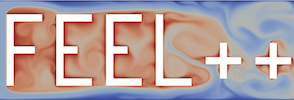Spectral element approximation of the incompressible Navier-Stokes equations in a moving domain and applications
Approximation élément spectral des équations de Navier-Stokes Incompressibles dans un domaine mobile et applications
Résumé
In this thesis we address the numerical approximation of the incompressible NavierStokes equations evolving in a moving domain with the spectral element method and high order time integrators. First, we present the spectral element method and the basic tools to perform spectral discretizations of the Galerkin or Galerkin with Numerical Integration (G-NI) type. We cover a large range of possibilities regarding the reference elements, basis functions, interpolation points and quadrature points. In this approach, the integration and differentiation of the polynomial functions is done numerically through the help of suitable point sets. Regarding the differentiation, we present a detailed numerical study of which points should be used to attain better stability (among the choices we present). Second, we introduce the incompressible steady/unsteady Stokes and Navier-Stokes equations and their spectral approximation. In the unsteady case, we introduce a combination of Backward Differentiation Formulas and an extrapolation formula of the same order for the time integration. Once the equations are discretized, a linear system must be solved to obtain the approximate solution. In this context, we consider the solution of the whole system of equations combined with a block type preconditioner. The preconditioner is shown to be optimal in terms of number of iterations used by the GMRES method in the steady case, but not in the unsteady one. Another alternative presented is to use algebraic factorization methods of the Yosida type and decouple the calculation of velocity and pressure. A benchmark is also presented to access the numerical convergence properties of this type of methods in our context. Third, we extend the algorithms developed in the fixed domain case to the Arbitrary Lagrangian Eulerian framework. The issue of defining a high order ALE map is addressed. This allows to construct a computational domain that is described with curved elements. A benchmark using a direct method to solve the linear system or the Yosida-q methods is presented to show the convergence orders of the method proposed. Finally, we apply the developed method with an implicit fully coupled and semi-implicit approach, to solve a fluid-structure interaction problem for a simple 2D hemodynamics example.
Dans cette thèse nous nous intéressons a l'approximation numérique des équations incompressibles de Navier-Stokes évoluant dans un domaine en mouvement par la méthode des éléments spectraux et des intégrateurs en temps d'ordre élève. Dans une première phase, nous présentons la méthode des éléments spectraux et les outils de base pour effectuer des discrétisations spectrales du type Galerkin ou Galerkin avec intégration numérique (G-NI). Nous couvrons un large éventail de possibilités concernant les éléments de référence, fonctions de base, points d'interpolation et points de quadrature. Dans cette approche, l'intégration et la différentiation des fonctions polynomiales est faite numériquement grâce a l'aide d'ensembles de points convenables. En ce qui concerne la différenciation, nous présentons une étude numérique des points qui doivent être utilisés pour atteindre une meilleure stabilité numérique (parmi les choix que nous avons actuellement). Deuxièmement, nous introduisons les équations incompressibles stationnaires et non-stationnaires de Stokes et de Navier-Stokes et son approximation spectrale. Dans le cas non-stationnaire, nous introduisons une combinaison de la méthode Backward Différentiation Formula (BDF) et une formule d'extrapolation du même ordre pour l'intégration par rapport au temps. Une fois les équations discrétisées, un système linéaire doit être résolu pour obtenir la solution approchée. Dans ce contexte, nous resolvons ce système avec un préconditionneur par blocs. Nous montrons que le préconditionneur est optimal par rapport au nombre d'iterations utilisées par la méthode GMRES dans le cas stationnaire, mais pas dans le cas non-stationnaire. Une autre alternative est d'utiliser les méthodes de factorization algébrique de type Yosida et séparer le calcul de la vitesse et de la pression. Un cas test est présente pour déterminer les proprietes de convergence de ce type de méthodes dans notre contexte. Troisièmement, nous 'tendons les algorithmes développés dans le cas ou le domaine est fixe au cadre de la formulation Arbitraire Lagrange-Euler (ALE). La question de la définition d'une carte ALE d'ordre élevé est aborée. Cela permet de construire un domaine de calcul qui est d'ecrit avec des éléments courbes. Un cas test utilisant une méthode directe et les méthodes Yosida-q pour resoudre le système linéaire est présente pour montrer les ordres de convergence de la méthode proposée. Finalement, nous appliquons la méthode développée pour résoudre une un problème d'interaction fluide-structure pour un exemple simple bidimensionnel d'hémodynamique. Nous considérons deux approches: une implicite entièrement couplée et une semi-implicite.
Loading...

